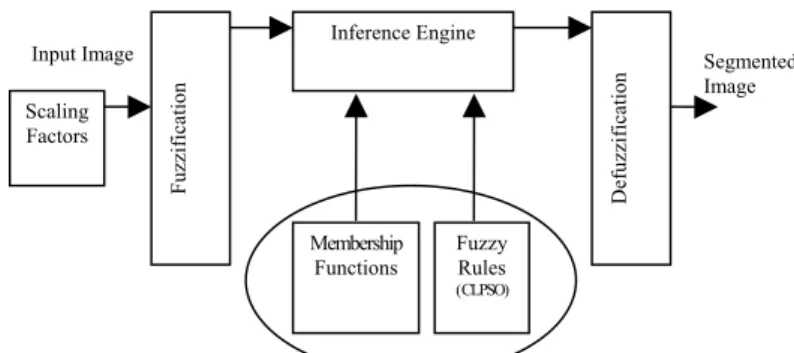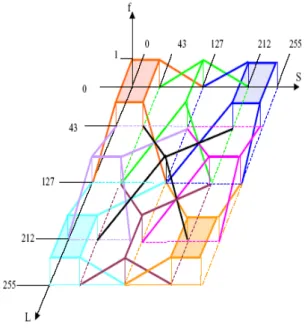Abstract— The aim is to produce a fuzzy system for color
classification and image segmentation with least number of rules and minimum error rate. Particle swarm optimization is a sub class of evolutionary algorithms that has been inspired from social behavior of fishes, bees, birds, etc, that live together in colonies. The comprehensive learning particle swarm optimization (CLPSO) technique is used to find optimal fuzzy rules and membership functions because it discourages premature convergence. Here each particle of the swarm codes a set of fuzzy rules. During evolution, a population member tries to maximize a fitness criterion and small number of rules. Finally, particle with the highest fitness value is selected as the best set of fuzzy rules for image segmentation
Index Terms— CLPSO, Color Classification, Fuzzy Logic, Image Segmentation
I. INTRODUCTION
The process of partitioning a digital image into multiple regions (set of pixels) is called image segmentation. The partitions are different objects in image which have the same texture or color. The result of the image segmentation is a set of regions that collectively cover the entire image. All of the pixels in a region are similar with respect to some characteristic or computed property, such as color, intensity, or texture. Adjacent regions are significantly different with respect to the same characteristics. Some of practical applications of image segmentation are: image processing, computer vision, face recognition, medical imaging, digital libraries, image and video retrieval [1]. Image segmentation methods fall into five categories: Pixel based segmentation [2], Region based segmentation [3], Edge based segmentation [4 5], Edge and region Hybrid segmentation [6] and Clustering based segmentation [7 8 9]. Color image segmentation using fuzzy classification is a pixel based segmentation method. A pixel is assigned a specific color by the fuzzy system. One approach in designing such a fuzzy system is an expert to look at training data and try to
1. Research Scholar, Department of Electronics and Communication Engineering, G.H.Raisoni College of Engineering, Nagpur, India (email: paragash2003@yahoo.co.in)
2. Senior Member IEEE & Principal, G.H.Raisoni College of Engineering, Nagpur, India (e-mail: preetib123@yahoo.com).
3. Lecturer & Research Associate, Department of Electronics & Communication Engineering, G.H.Raisoni College of Engineering, Nagpur, India (e-mail: prasanna_palsodkar@yahoo.co.in).
manually develop a set of fuzzy rules. The block diagram is shown in Fig.1
Fig. 1 – Block Diagram of Fuzzy Based CLPSO II. FUZZY COLOR CLASSIFICATION
Fuzzy color classification is a supervised learning method for segmentation of color images. This method assigns a color class to each pixel of an input image by applying a set of fuzzy rules on it. A set of training image pixels, for which the colors are known, are used to train the fuzzy system.
Different color spaces like HSL, RGB, YIQ, etc. have been suggested in image processing, each suitable for different domains. HSL color space is used because a color in this space is represented in three dimensions: one which codes the color itself (H) and another two which explain details of the color, saturation (S) and lightness (L). As it can be seen in Fig. 2, H dimension is shown in a circle with colors occupying a range of degrees around it. Instead of assigning a specific hue value to each color around this circle, a fuzzy membership function can code for a color by giving it a range of hues each with different membership value. As an example, H dimension in Fig. 3 is partitioned into ten trapezoidal membership functions each one coding a different color. [1]
Fig. 2 – H and S dimensions
Fuzzy based Color Image Segmentation using
Comprehensive Learning Particle Swarm
Optimization (CLPSO) – A Design Approach
Parag Puranik, Dr. P.R. Bajaj, Prof. P.M. Palsodkar
Fuzzification
Inference Engine
Defuzzification
Scaling Factors
Membership Functions
Fuzzy Rules
(CLPSO)
Input Image Segmented
Image
Proceedings of the International MultiConference of Engineers and Computer Scientists 2009 Vol I IMECS 2009, March 18 - 20, 2009, Hong Kong
Fig. 3 – Partitioning H dimension with trapezoidal membership function
Trapezoidal membership function showed in Fig. 4 needs four parameters to be specified [1].
Fig. 4 – Trapezoidal Membership function
To represent two remaining dimensions of a color, because of their less importance for determining a color compared with Hue dimension, each dimension is divided into three parts: weak, medium and strong. Combining these two dimensions nine regions for representing a color shown in Fig. 5 are obtained. A two dimensional membership function is then placed on each region. In order to generate two dimensional membership functions, three 1D trapezoidal membership functions is placed over each dimension and then by multiplying these functions a set of nine 2D membership functions is generated. Fig. 6 illustrates above concept.
Fig. 5 –Color representation on S and L dimensions
Fig. 6 – Fuzzy Membership on S and L Each fuzzy rule is represented as follows:
j – th rule:
if x1 is Aj1and x2 is Aj2 and…xm is Ajm then x = (x1, x2,…., xm) belongs to class Hj with CF=CFj j=1,2,…., R
in which R is the number of fuzzy rules, m is the dimensionality of input vector, H j ε {1,2,….,M} is output of the jth rule, M is the number of color classes, CFj ε [0,1]
is the certainty factor of jth rule.
III. COMPREHENSIVE LEARNING PARTICLE SWARM OPTIMIZATION
Particle Swarm Optimization (PSO) algorithm is motivated by social behavior of organisms such as bird flocking and fish schooling [10], [11]. PSO as an optimization tool provides a population-based search procedure in which individuals called particles change their position (state) with time [12]. In PSO, individuals represent points in the n-dimensional search space [12]. A particle represents a potential solution. The velocity d is the best position discovered by the whole population. pbest which is the previous best position and gbest is the best position positions respectively [13] are chosen Although there are numerous variants for the PSO, premature convergence when solving multimodal problems is still the main deficiency of the PSO. In the original PSO, each particle learns from its
pbest and gbest simultaneously. Restricting the social
learning aspect to only the gbest makes the original PSO converge fast. However, because all particles in the swarm learn from the gbest even if the current gbest is far from the global optimum, particles may easily be attracted to the gbest
region and get trapped in a local optimum if the search environment is complex with numerous local solutions. A particle that has discovered the region corresponding to the global optimum in some dimensions may have a low fitness value because of the poor solutions in the other dimensions. CLPSO is a novel learning strategy that improves the original PSO, all particles’ pbest are used to update the velocity of any Deep Dark
Somber
Bright Medium Gray
Luminous Light Pale
Lumi
nance
Saturation
Proceedings of the International MultiConference of Engineers and Computer Scientists 2009 Vol I IMECS 2009, March 18 - 20, 2009, Hong Kong
one particle. CLPSO ensures that the diversity of the swarm is preserved to discourage premature convergence referred to learning probability, which can take different values for different particles. For each dimension of particle i , a random number is generated. If this random number is larger than i, the corresponding dimension will learn from its own pbest; otherwise it will learn from another particle’s pbest. Selection procedure when the particle’s dimension learns from another particle’s pbest as follows:
1) Randomly choose two particles out of the population which excludes the particle whose velocity is updated.
2) Compare the fitness values of these two particles pbests and select the better one.
3) Use the winner’s pbest as the exemplar to learn from for that dimension. If all exemplars of a particle are its own
pbest, we will randomly choose one dimension to learn from
another particle’s pbest’s corresponding dimension.
All these pbestfican generate new positions in the search
space using the information derived from different particles’ historical best positions [13].
IV. FUTURE SCOPE
A new method for segmentation of color images using a CLPSO-based fuzzy system was introduced in this paper. A particle of the swarm codes for a set of fuzzy rules. A fitness function rates for the Optimality of each particle. The particles try to maximize fitness function by cooperative working. This process is continued until either maximum number of iteration is met or average velocity approaches zero. Future scope includes applications like computer vision, medical imaging, face recognition, digital libraries and image and video retrieval.
REFERENCES
[1] A.A. Younes, I. Truck, and H. Akdaj, “Color Image Profiling Using Fuzzy Sets,” Turk J Elec Engin, vol.13, no.3, 2005.
[2] G.A. Ruz, P.A. Estévez, and C.A. Perez, “A NeurofuzzyColor Image segmentation Method for Wood SurfaceDefect Detection,” Forest Prod. J. 55 (4), 52-58, 2005.
[3] Moghaddamzadeh and N. Bourbakis, “A Fuzzy Region Growing Approach for Segmentation of Color Images,” Pattern Recognition, 30(6):867-881, 1997.
[4] G.S. Robinson, “Color Edge Detection,” Opt. Eng, 16(5): 479-484, 1977.
[5] J. Canny, “A Computational Approach to Edge Detection,” IEEE
Trans. Pattern Anal. Mach. Intell, 8(6): 679-698, 1986.
[6] Shiji and N. Hamada, “Color Image Segmentation Method Using Watershed Algorithm and Contour Information,” Proc. Inter. Conf. on
Image Processing,4:305-309, 1999.
[7] B. Zhang, “Generalized K-harmonic Means–boosting in Unsupervised Learning,” Technical report (HPL-2000–137), Hewlett-Packard Labs, 2000.
[8] J. Bezdek, “A Convergence Theorem for the Fuzzy ISODATA Clustering Algorithms,” IEEE Trans Pattern Anal Mach Intell, 2:1-8, 1980.
[9] K. Huang, “A Synergistic Automatic Clustering Technique (Syneract) for Multispectral Image Analysis,” Photogrammetric Eng Remote Sens, 1(1):33–40, 2002.
[10] R.H. Turi, “Clustering-based Color Image Segmentation,” PhD Thesis,
Monash University, Australia, 2001. [18] C.S. Wallace and D.M.
Boulton, “An Information Measure for Classification,” Comput J,
11:185-194, 1968.
[11] Y. SM and R. Eberhart, “Fuzzy Adaptive Particle Swarm Optimization,” Proc. Congress on Evolutionary Computation, Seoul, S. Korea, 2001.
[12] R.O. Duda and P.E. Hart, Pattern Classification and Scene Analysis, John Wiley & Sons, New-York, 1973. C.C. Chen, “Design of
PSO-based Fuzzy Classification Systems,” Tamkang Journal of
Science and Engineering, vol. 9, no. 1, pp. 63-70, 2006.
[13] J.J. Liang, A.K. Qin, and S. Baskar, “Comprehensive Learning Particle Swarm Optimizer for Global Optimization of multimodal Functions,”
IEEE trans. EvolutionaryComputation, vol. 10, no. 3, June, 2006.
Proceedings of the International MultiConference of Engineers and Computer Scientists 2009 Vol I IMECS 2009, March 18 - 20, 2009, Hong Kong

